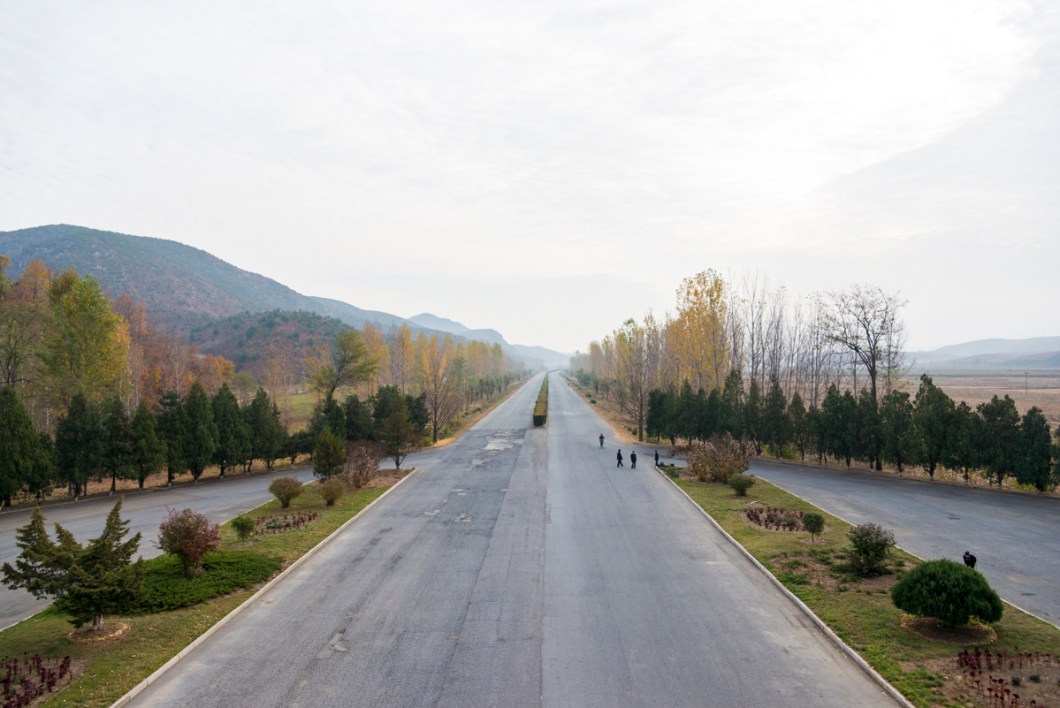
Visiting North Korea
[vc_row row_type=”row” use_row_as_full_screen_section=”no” type=”full_width” text_align=”left” css_animation=””][vc_column][vc_column_text]
[dropcap]I[/dropcap] have, for quite a few years, wanted to visit North Korea with the intention of taking pictures. To visit North Korea as a tourist is now fairly easy, thanks to companies like Koryo Tours and Young Pioneers. But to visit as a photographer requires a little more work, and through collaboration with Norwegian artist Morten Traavik, the opportunity arose at the end of 2014. I was lucky to arrive just before the Ebola curtain came down on the country, closing the borders for all foreigners with a 21 day curfew. As an educator and photographer, I wanted to see the schools of Pyongyang, and what the future of North Korea looks like.

View from Juche tower. Taedong river on the right side, dividing Pyongyang in two.

Roller skating is very popular in Pyongyang.

Visit to Pyongyang Middle School #1.

Part of the portrait series of students in North Korea.
I submitted a request to be able to do portraits of students, and my guides were able to put together an interesting schedule for me. My initial idea was to show that people are people wherever you go in the world – and I wanted to show North Korean students and children, who will one day be the next generation running the country. Besides the usual spots you will be shown when visiting North Korea, I was able to visit many schools in the district and interact with the students.
This was a great experience, and I could speak freely about any topic with them. English is being taught as an elective in schools, so most of the students I met were able to talk with me and exchange both ideas and mutual understanding. I found that Norwegian humor actually works in North Korea – to my surprise. Some people will argue that when meeting people in North Korea, they are all hand picked for you by the government. In my case, I had so many interactions that if this was the case, it would have been a full-time job for the people prepping the students and children I met during my trip. I dont believe that this was the case. Obviously they are aware of my visit, as would my students have been if a North Korean photographer came to visit, but the ability to speak freely about topics, and stop to talk to random people, came to me as a surprise.
The portrait series I took was done in natural light in one of the classrooms. I asked them if I could take their pictures individually – of which they were a little hesitant. As any 16 year old kid would be. I explained my intentions about the pictures, and eventually some of the students came up and had their picture taken. It was both awkward and fun, and they reacted just as how my students would have reacted in that type of situation. All the pictures I took have been sent back to the students in North Korea, together with individual pictures of my own students, so they can see what they look like in Norway.







Children learning about rhythm at Kyongsang Kindergarten.

Tower of Juche ideas as seen from the other side of the Taedong river.

Classroom in an elementary school in Pyongyang.

The road to the DMZ, the border between North and South Korea.
I was able to wander around as I wanted without guides in Pyongyang. I did not think this was possible, as most western media tells us that it is impossible for foreigners to move freely without guides or supervision. I could not take pictures without being with my guides, though. However, my guides never disallowed me to take any pictures, besides photographing the military. Due to the borders being closed, the hotel was extremely quiet, and there were almost no foreigners to be seen – even my guides felt it was a strange atmosphere.
Whenever I asked to do something, my guides were extremely helpful and willing to try to do their best to fulfil my wishes. It is important to note that the guides who both act as interpreters and liaisons for the government and have been instructed on rules with regards to what is appropriate for you to photograph, at least to a certain degree. I was still surprised, due to what I had read in western media about restrictions in North Korea, at how much I was able to do and see.

Farmer about two hours south of Pyongyang.

City outside of Kaesong, close to the border of South Korea.

Ryugyong hotel, the largest building in the city.
Jørund Føreland Pedersen is a lecturer at Noroff Kristiansand, Norway. Currently teaching photography and visual arts.
Check his work here: http://www.repost.no/home & on ello here: @joerund
[/vc_column_text][/vc_column][/vc_row]





